"Tanks drive through people like wood." The third assault on Stalingrad. H. 2
Completion of the third assault
The battles for Stalingrad impressed with their bitterness and perseverance. It was a real battle of the titans. Russians and Germans have shown themselves to be the best fighters on the planet. The exploits of the fighters of the Pavlov’s House, which held him for 58 days (until November 25, 1942), became world famous. The defense of the famous Stalingrad house was led by Lieutenant Ivan Afanasyev and Sergeant Yakov Pavlov. Under their command there were from 24 to 31 soldiers. In the basements were also more than thirty civilians, some were injured. The enemy was striking this house aviation, fired artillery and mortar fire, but the defenders of the house did not retreat a single step. The Germans organized attacks several times a day. Every time the soldiers and Tanks they tried to get close to the enemy close to the house, Afanasyev and his comrades met them with heavy fire from the basement, windows and roof. It came to the point that in the operational map of the German commander of the Stalingrad group Paulus, "Pavlov’s house" was designated as a fortress. Marshal V. Chuykov said in his memoirs: "This small group, defending one house, destroyed more enemy soldiers than the Nazis lost when they captured Paris."
The words of the sniper VG became the motto for all Soviet soldiers. Zaitseva: “For us, the soldiers and commanders of the 62 Army, there is no land outside the Volga. We stood and we will stand to the death! ”. Almost three hundred killed Nazis were in the account of the famous Soviet sniper.
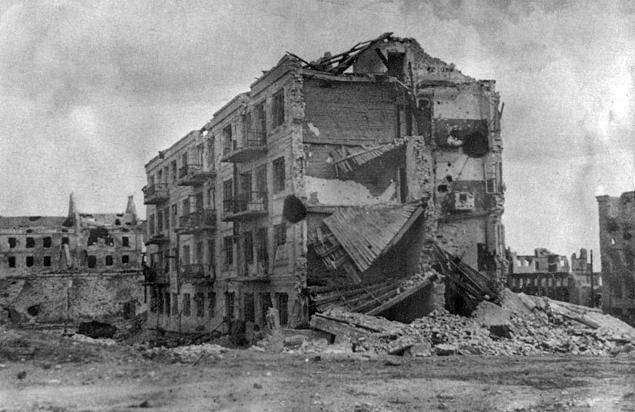
Pavlov's House
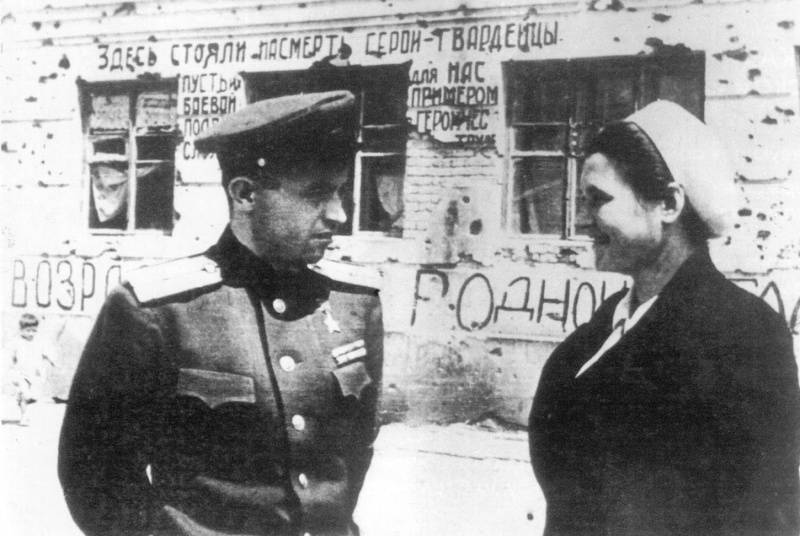
Ya. F. Pavlov and A. M. Cherkasov - Brigadier of the 1 Volunteer Brigade for the Restoration of Stalingrad talk against the background of the building that was damaged by the fighting. Picture taken after June 1945 of the year - on the chest of Pavlov the Star of the Hero of the Soviet Union, this title was awarded to him 17 June 1945 of the year
In the area of the Barrikady plant, Siberian warriors of the 308 th rifle division fought under the command of Colonel L. N. Gurtieva. They fought off some 100 German attacks in October. There were days when Soviet soldiers fought off, one by one, five, ten and more attacks. And not only reflected, but also passed into counterattacks. Three German divisions supported by aviation and artillery were attacking this division. Colonel Gurtyev, a participant in the First World War and the Civil War, a battle-hardened military leader, with his skill and composure inherent in him, led the actions of his units, who in the days of the October and November battles fought in the direction of the main attack of the German army. The soldiers of the 138 Infantry Division under the command of a talented military commander Colonel I. I. Lyudnikov also fought. In mid-October, when the 138 Infantry Division arrived to help the defensive village and the Barrikady plant of the 308 Infantry Division, the enemy strengthened its grouping here, concentrating four infantry divisions and one tank division in a narrow area. The positions of the Soviet soldiers attacked large masses of tanks. Soon the battles were transferred directly to the factory territory, the 308-I and 138-I divisions continued to fight with the superior forces of the enemy. Together with the Soviet soldiers, shoulder to shoulder with them, the factory workers fought.
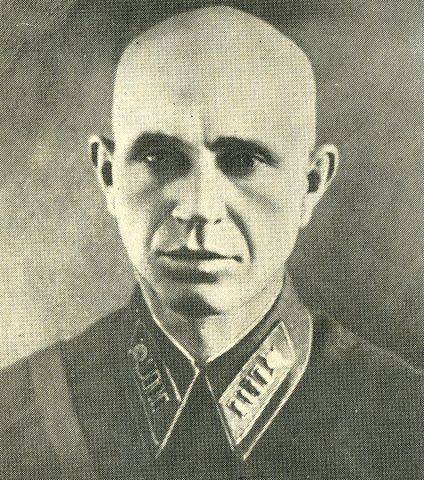
Komdiv Leonty Nikolaevich Gurt'ev (1891-1943)
Meanwhile, the Soviet command increased its forces in the Stalingrad sector. In order to eliminate the possibility of enemy forcing the river, at the direction of the Headquarters in October, three fortified areas were thrown from the other fronts into the defense system of the 2 tank corps: 77, 118 and 156 from other fronts. To the south of the city, the 61 and 87 cavalry divisions of the 4 th cavalry corps are concentrated, and in the Dubovka, Vyazovka area, the 7 rifle corps (93, 96 and 97 rifle brigades) were concentrated. The 169 and 45 rifle divisions also arrived at the Stalingrad Front. From the Reserve Betting in the Don Front, seven rifle divisions arrived. In order to create a solid defense of the Volga islands in the area of Stalingrad - Spore, Zaitsevsky, Golodny and Sarpinsky - the Headquarters sent artillery and machine gun battalions to the Stalingrad Front in early October. For the same purpose, the 45-Infantry Division under the command of Colonel V.P. Sokolov, one regiment of air defense and 20 of large-caliber machine guns was transferred to the front.
Unable to develop a breakthrough along the bank of the Volga towards the Barricades factory, the Germans attempted to advance north from the FTZ to Spartanovka. But here the enemy was stopped by a group of colonel Gorokhov, fighting in the area, in 8 sq. km in the area between the Volga River. Mosque and P. Latosanka. “On November 2, the battle resumed with a new force,” noted Major General S. F. Goruv. “The Nazis tried to suppress us with the power of fire. At 7 hours of the morning, after a raging artillery and mortar raid, bombing began, which lasted 10 hours in a row. On this day, Colonel V. A. Bolvinov (commander of a rifle brigade from a surrounded group) died, his dugout was broken by a direct bomb hit. ... In the 17 watch the Nazis launched an attack with tanks. Our fire weapons greeted them as before, as if there was no painful shelling and frantic bombardment of our positions. The attack was repelled. A large role in this battle was played by our artillery, which was on the islands. Two days later, the enemy repeated the bombing. This time, he bombed not only us, but also the left bank of the Volga and the islands where our artillery firing positions were located. And when the Nazis went on the attack again, they were met with merciless fire. All enemy attempts to dislodge us from the occupied lines were unsuccessful. ”
A stubborn battle continued in the area of the Red October plant. Here the defense was held 39-I Guards Rifle Division Guriev. In the second half of October, after heavy six-day battles, the Germans made their way into the factory and 27-s captured its north-western part. The fighters fought day and night for every house, trench, but the enemy never broke through to the Volga. Although the troops 62-th army had even closer to the river. On October 29, the front command sent the personnel of the 45 Infantry Division, commanded by Colonel V.P. Sokolov, with a company of 235 tank brigades, to arrive from the Guryev’s division. This made it possible to organize a X-strike against 31 in October, supported by front aviation and a front artillery group. The warriors of Guryev and Sokolov decisively counterattacked the enemy from the largest workshops and from the warehouse of finished products of the Krasny Oktyabr factory. In the future, right up to the transition of our troops to the counteroffensive, the struggle on the territory of the plant continued with great tenacity, but the enemy was not able to seize the whole area of the plant and reach the Volga.
In the meantime, the bloodless and tired German troops, having failed to break the defenses of Chuikov’s army and complete the operation to seize the city, began to go over to the defenses, trying to keep the occupied territory. From the beginning of November, in the defense zone of the 62 and 64 armies, the troops of the German 6 were operating only in small groups. The German army was replenished with manpower and equipment, fixed the captured positions. At the military disposal of the 62 Army Headquarters 10 November, it was noted that the enemy in front of the army began to build fortifications (bunkers) and anti-personnel and anti-tank barriers, securing the occupied territory and thus complicating the offensive actions of the Soviet troops. In this regard, it was proposed to conduct around-the-clock continuous observation of the enemy and to open machine-guns and artillery at all observed work sites, disrupting the construction of obstacles and obstacles.
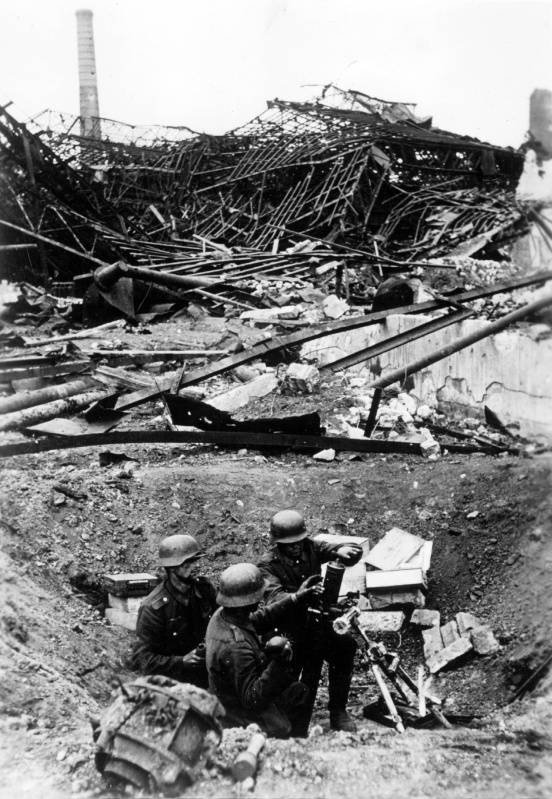
German mortar crew firing at Soviet troops from 81-mm mortar (8-cm GW34) among the ruins of the Red October plant in Stalingrad.
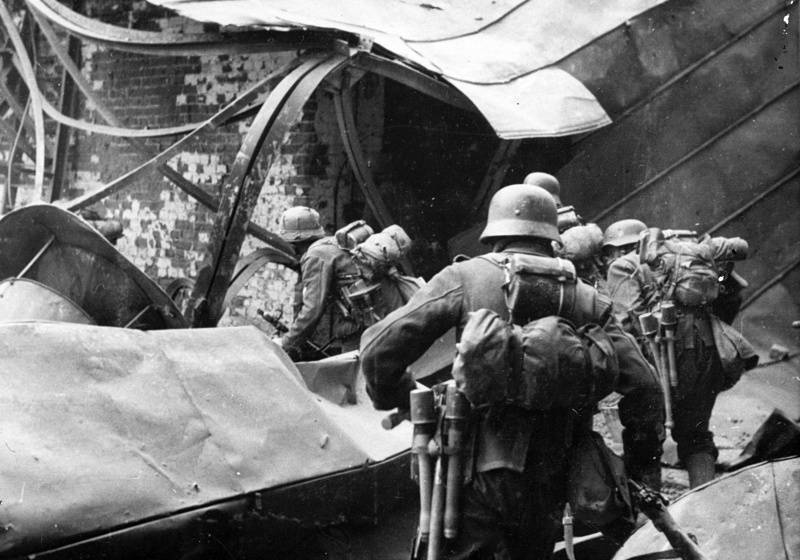
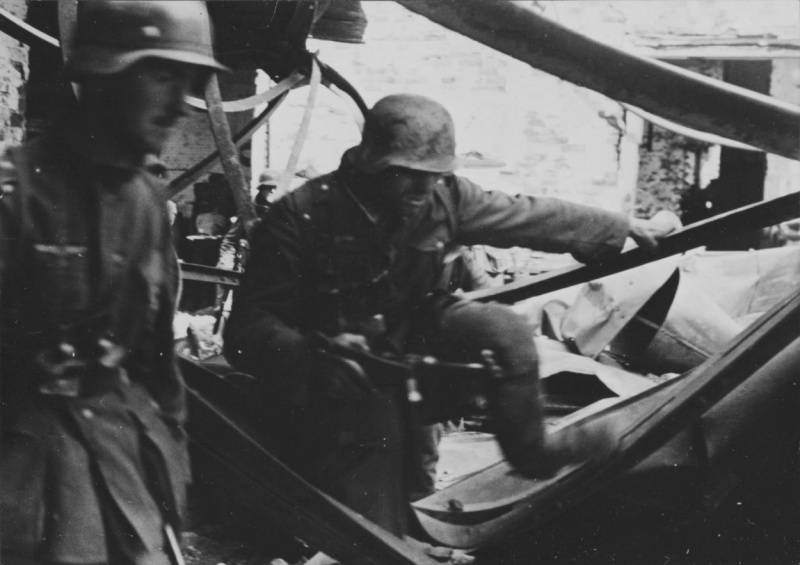
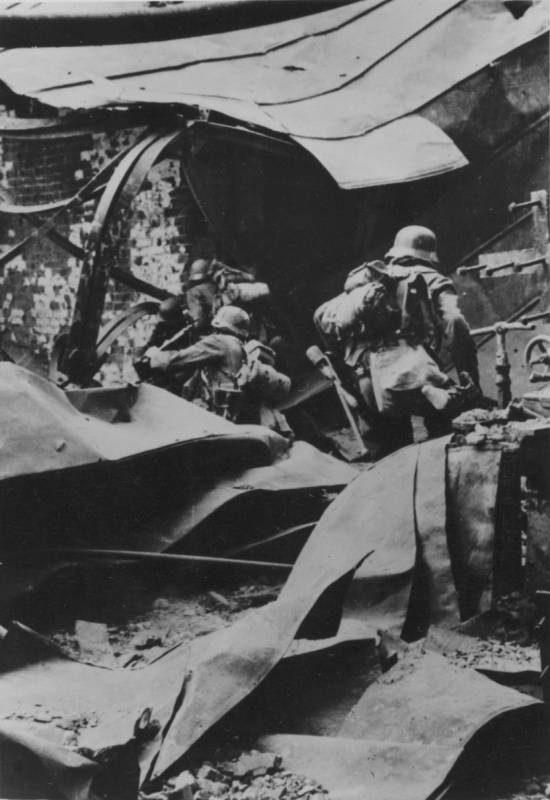
German soldiers take positions in battle in the zone of the Red October plant in Stalingrad
Counterstrike Soviet troops
To facilitate the position of the 62 Army, 19 of October 1942, from the area north of the city, the Don Front launched an offensive. At first, the Kommersant Rokossovsky comfronts posed much more decisive tasks: to break through the enemy defenses, unite with the troops of the Stalingrad Front, and destroy the enemy grouping that had broken through to the Volga. The main blow inflicted 66-I army of General Zhadov. To ensure the combat mission of the army, in addition to its 5 rifle divisions, 4 divisions from the 24 Army and 4 were given full rifle divisions from the Betting reserve, as well as the 23 artillery regiment of the GDG, 12 rocket artillery regiments, several tank brigades. As a result, Zhadova had 74 guns for every kilometer of the front line, not counting mortars and rocket launchers. The front aviation worked in the army sector, carrying out the tasks of storming the enemy and covering its units from the air.
During the period from 20 to 26 in October, the 66-I army, continuously attacking, advanced only 3 km and the offensive operation failed. Losses at the same time amounted to about 18 thousand people. Speaking about the reasons for the failure, Rokossovsky and Zhadov stated that the infantry, especially the newly arrived divisions, was poorly trained and offered to stop the offensive: “... People are not trained and completely unprepared, many do not know how to own a rifle. Before you fight, you need to train and prepare a new division for at least a month. The command staff, both middle and senior tactically illiterate, cannot navigate the terrain and loses command and control in combat ... In the presence of large artillery fire and massed raids of our aircraft, units advance very slowly ... The enemy aviation showed no activity. The enemy forces in front of the front of the 66 Army are insignificant, the enemy has assembled soldiers from the rear areas ... ”. Thus, the Germans, even with small forces, repelled the poorly organized attack of the Red Army.
The operation was unsatisfactory. A special department of the Don Front in the report to his superiors was noted primarily by the mediocre and inept leadership of the regimental commanders, divisions and the commander himself General Zhadov. The artillery also acted poorly; it was not possible to use the accumulated power: it opened fire either long before the infantry units reached the initial line for an attack, or they beat at their own, since the artillery commanders did not organize observation and the corresponding adjustment according to the results of the shooting. Separate parts in general did not receive ammunition and did not fire. Aviation periodically acted in the same spirit, striking at the leading edge of its troops. Moreover, the soldiers of the 66 army were poorly supplied and cases of lack of food were observed: “Due to poor nutrition and exhaustion of the soldiers, 587 and 692 deaths were recorded in 212 and 23 SP. In 62 DM, 9 deaths are noted. Medical commissions found that death was caused by exhaustion and overwork of the body. Despite the presence of signals, neither the command of the army, nor the command of the front took appropriate measures through the institutions of the rear to organize a normal supply. ”
South of Stalingrad, our troops also tried to attack. From 22 October, 1942, the 64 Army's strike group was advancing: 422 and 126, Infantry Divisions, 93, 96 and 97 Infantry Brigades of the 7 Corps, 13, 50, 90-I and 155-I tank brigades. Our troops attacked in the Kuporosnoe, Zelenaya Polyana area at the junction with the 62 army. Soviet troops advanced several kilometers and were thrown back to their original positions. On October 25, the army of Shumilov again launched an offensive in the same direction, which began after the 40-minute artillery preparation and air strike. Hard fighting continued until November 1. The troops advanced 3-4 km and captured the southern part of the Kuporosnoe.
The situation on the front line resembled hell. These days, the fighter 422 th Infantry Division VI. Kovalenko, in a letter to his mother, said: “I am alive, and in a second, maybe they will be killed, because here life is second. Although you are writing not to think about death, but I do not think that I live, because there are very strong battles, a lot of people are killed, the corpses lie on the ground, look terrible: both the Germans and ours are poor, they rot and nobody needs , even buried, and then roll like sheaves. Tanks ride on people, like wood. The tank is covered in blood, it is terrible to watch. With me there are such comrades who are wounded from the first battle, there are those who do not have time to see the German, how they will kill him or injure him. ”
Thus, the success of flank counterattacks was small. However, for several days the enemy suspended the battles in the factory part of Stalingrad and our troops for some time delayed the regrouping of forces undertaken by the German command and the start of the fourth assault on Stalingrad.
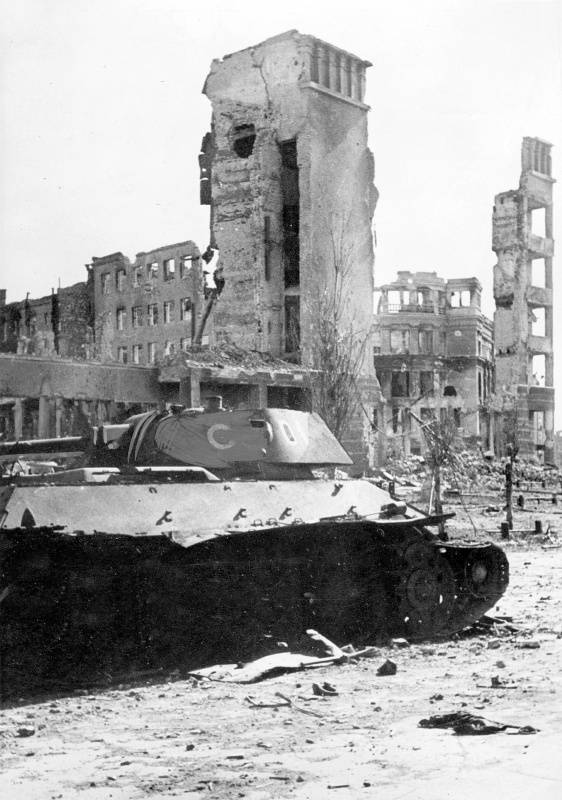
Tank T-34 / 76 (produced by STZ) of the 6 Tank Brigade, shot down on Gogol Street in the center of Stalingrad
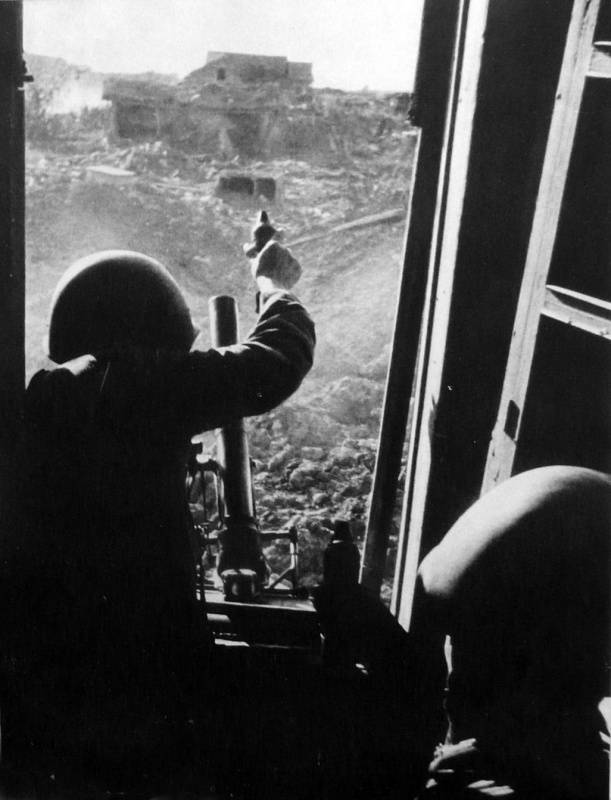
Soviet calculation of 50-mm company mortar firing in Stalingrad
Results
For a whole month there were fierce battles all along the defense line of the 62 and 64 armies, but the Wehrmacht did not manage to break through the defenses of the Soviet troops. The German troops, in spite of their enormous combat experience and material and technical advantage, only in certain sectors, advanced a few hundred meters, reached the Volga. The enemy, having suffered heavy losses, failed to capture the whole city, including its coastal part.
In strategic terms, the Soviet Stalingrad group continued to rivet the forces and attention of the enemy. The Wehrmacht halted the offensive on the entire Soviet-German front and attacked only in the area of Stalingrad.
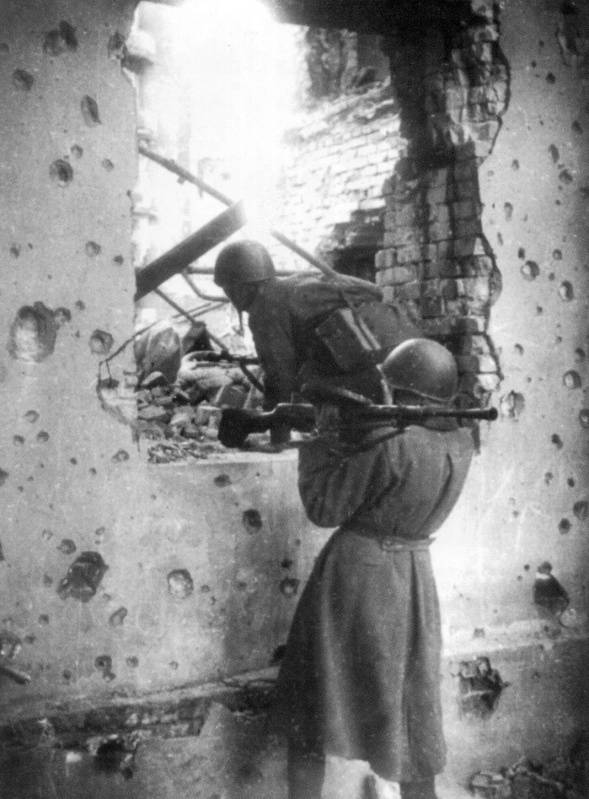
Soviet machine-gun crew changes firing position in a broken house in Stalingrad
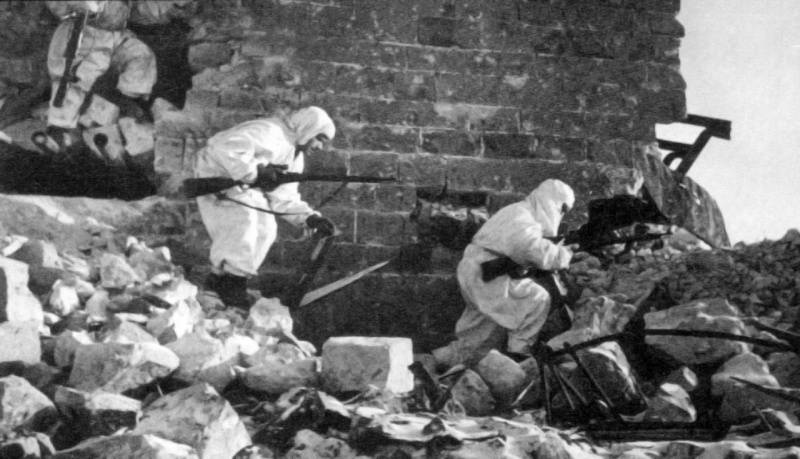
Soviet snipers go to the firing position in a ruined house in Stalingrad
Information